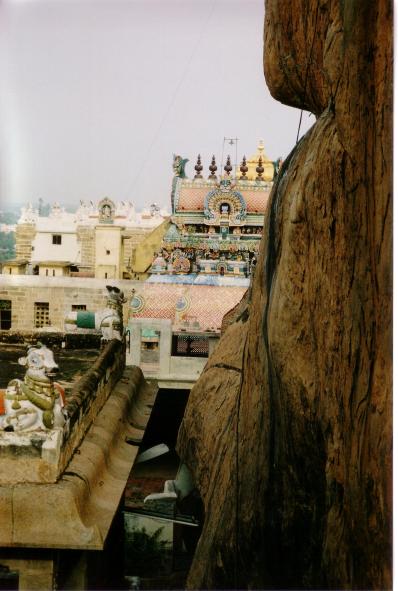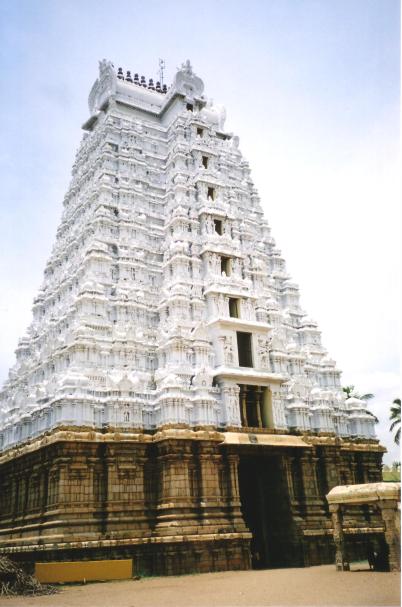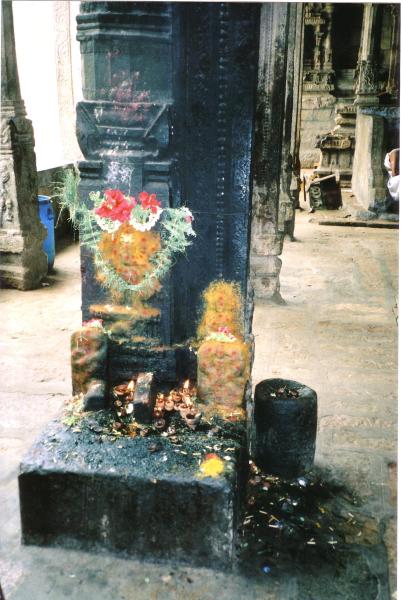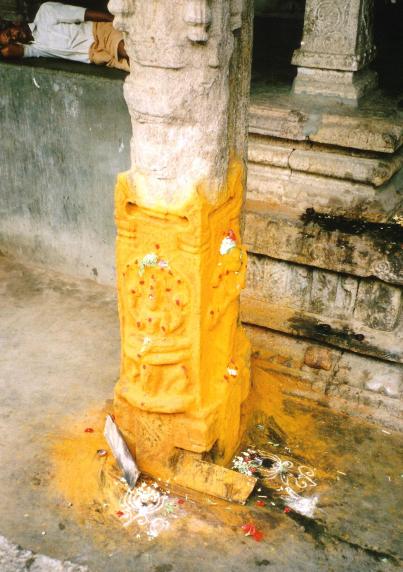Southern India differs from the north in several respects. The first difference that the visitor tends to notice, once they have got away from the typical Indian maelstrom of airport, traffic, city centre, etc, is that with the less densely concentrated population comes a somewhat more laid-back atmosphere and attitude than in the north. The hassles and pressures, the touts, are still there, but seem somehow less intense.
The second real difference is in the culture. Southern India was never really assimilated into the Mogul empire, and only ever partly conquered, so there is a huge wealth of Hindu architecture and a proportional lack of Islamic, with next to no Buddhist remains and no continuing tradition of Buddhism at all. At times, it seems as though the visitor has entered a different country, but India has a way of reasserting itself on the senses…

Stall outside Sri Ranganathaswamy Temple, Tiruchirappalli (Trichy), Tamil Nadu State. All over India, amongst the heat, dust and drabness that pervades the majority of the population’s day to day life, one finds colour.

Garland seller outside Rock Fort Temple complex, Trichy. The garlands will be used to decorate statues of gods during pujas (ceremonies) conducted in the Temples.

Rock Fort temple, Trichy. A view of the main temple from the pathway that leads to the tiny temple at the top of the rock. Non Hindus are not allowed into the main temple, dedicated to Shiva, or the temple at the top dedicated to Ganesh…although for a small donation, the priest is willing to waive this rule…
From my journal:
‘The trip is not particularly uncomfortable. It is a typical five hour trip through India – dust, buffaloes, half a dozen schoolchildren stuffed into an autorickshaw, wait-till-the-other-guy-blinks over-taking, temples large, medium and small, huge dry river beds, The Cauvery full of water, trees, strange crops, broken down trucks, train lines stretching arrow-straight into the distance, rows and rows of stalls with neat piles of fruit and vegetables, rows of hanging water bottles from the roof, biscuits, samozas, cigarettes and crisps, a child squatting in the dirt, mum feeding the family beneath the tree, ‘Tiffin Ready’ signs, smart petrol stations, mud huts, cement buildings, palm shacks, huge residences surrounded by high walls – all concrete, police traffic blocks (ignored), it all blurs into one.’

Part of Sri Ranganathaswamy Temple complex. This is the largest of all temple complexes in India, covering a staggering 60 hectares, and is dedicated to Vishnu. The Gopuram (tower) on the left is painted white, as a symbol of purity, and is one of the buildings that non-hindus are not permitted to enter.

The White gopuram, in all its glory.

Pillar in Sri Ranganathaswamy Temple, liberally decorated with coloured powders and with offerings of incense, rice and flowers. Devotees of the god concerned will conduct their own personal pujas to ensure health and prosperity, or perhaps for some more specific purpose, such as to request the birth of a son or success in a particular undertaking. Although this temple is dedicated to Vishnu, other gods are represented there and prayed to.

Another, nearby, pillar in the same temple. Although in the same temple and close to the pillar in the previous picture, this shrine will be to another, different, god. Its use, however, will be the same.

Without actually wanting to go, I am envious of the experience Mick.
LikeLiked by 1 person
It’s a great place, Frank. And definitely more laid back than Northern India.
LikeLiked by 1 person
Your accounts of journeys in that part of the world do a good job for armchair travelers, like me.
LikeLiked by 1 person
Thank you. Glad to be of service!
LikeLiked by 1 person
This is just glorious. You make Michael Palin look like a proper amateur. I feel like I’m right there!
LikeLiked by 1 person
Ha ha! I’m sure it does help, though, when you have the full resources of the BBC behind you when you travel. We often comment on this when watching those programs – Joanna Lumley has just done a short series on India and it’s remarkable how she, like all the other travellers who manage to make these films, met the Dalai Lama and managed to visit various places that are off-limits to other travellers.
Jealous? Moi?
LikeLiked by 1 person
Once they hear about you, they’ll be BEGGING you to come to their secret places, I tell you! I heard that the Dalai Lama is very keen to meet you and quite right too.
LikeLiked by 1 person
And I hear the BBC pay us blokes a good wage, too. Sounds like a plan.
LikeLiked by 1 person
I reckon so. Once your in, mention our plans for Carry On Poirot. They’re bound to be impressed.
LikeLiked by 1 person
Sounds like an even better plan!
LikeLiked by 1 person
Pingback: Southern India (1) – maylynno
Reblogged this on maylynno and commented:
Loved the accurate description of this trip!
LikeLiked by 1 person
Thank you, and thanks for visiting and commenting.
LikeLike
Hi Mick, Thanks for sharing the vivid description and lovely pictures of Sri Ranganathaswamy Temple complex. The temple architecture of South India is very different from the temple architecture of North India. Culturally too these two parts are poles apart. However, though the Moguls could not rule over the southern part, South India had its own set of Muslim rulers like the Nizams of Hyderabad and Tipu Sultan in Mysore. So you would find Ismalic architecture in these states.
LikeLiked by 1 person
Hi Somali. My knowledge of Southern India is much poorer than of Northern India, I’m afraid. The only state I visited was Tamil Nadu, and although I know a little about Tipu Sultan, I’m certainly hazy about the ‘boundary’ between what might be called the North and South of Muslim India. I shall have to brush up on that! Thank you!
LikeLiked by 1 person
A lovely description of this part of India. You really bring the country to life especially with the detail in your journal entry which conjured up vivid and wonderful images for someone like myself who has never had the opportunity to travel to that part of the world (or anywhere else, come to that). I very much enjoyed reading this and am looking forward to part two of your account.
LikeLiked by 1 person
Thanks, Ellie. It won’t be too long, I’m sure.
LikeLike
People in southern India are generally more soft in contrast to North. Maybe because they never had to face invaders, war and death. This difference is noticeable. The literacy levels too are higher.
LikeLiked by 1 person
That’s an interesting observation, Arv, that I haven’t heard before. I suppose the South saw less violence during Partition, although I don’t know that as a definite fact.
LikeLiked by 1 person
Its got to do with history longer than partition. May be when the Mughal and other attackers invaded India. May be ….
LikeLiked by 1 person
I do try to look up your location on the good old Goolge maps when I am reading so I am see where exactly you are. I am amazed by the splendid architecture and wish to visit even more. Its such a vast country where do you begin. I rather like the idea of this location, so thank you
LikeLiked by 1 person
It is vast, Jackie. Although we were there for three weeks, we saw nothing, really. The tiniest fraction of it.
LikeLike
You have really gone thoroughly 😄
LikeLiked by 1 person
Thank you. I think what comes over is that it made a great impression on me.
LikeLiked by 1 person
Not many people will have your eyes though
LikeLiked by 1 person
Very kind.
LikeLike